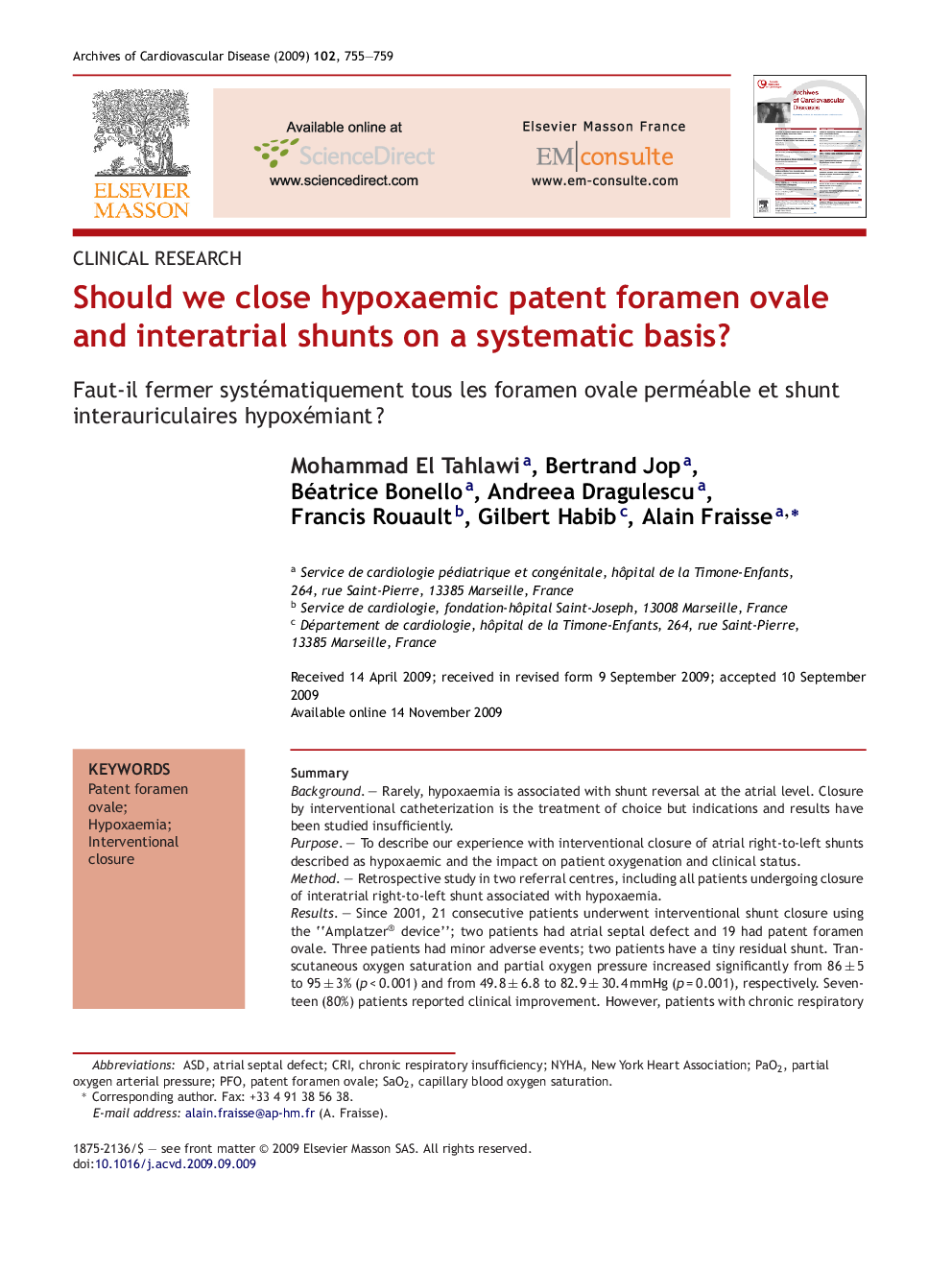| کد مقاله | کد نشریه | سال انتشار | مقاله انگلیسی | نسخه تمام متن |
|---|---|---|---|---|
| 2889905 | 1574399 | 2009 | 5 صفحه PDF | دانلود رایگان |

SummaryBackgroundRarely, hypoxaemia is associated with shunt reversal at the atrial level. Closure by interventional catheterization is the treatment of choice but indications and results have been studied insufficiently.PurposeTo describe our experience with interventional closure of atrial right-to-left shunts described as hypoxaemic and the impact on patient oxygenation and clinical status.MethodRetrospective study in two referral centres, including all patients undergoing closure of interatrial right-to-left shunt associated with hypoxaemia.ResultsSince 2001, 21 consecutive patients underwent interventional shunt closure using the “Amplatzer® device”; two patients had atrial septal defect and 19 had patent foramen ovale. Three patients had minor adverse events; two patients have a tiny residual shunt. Transcutaneous oxygen saturation and partial oxygen pressure increased significantly from 86 ± 5 to 95 ± 3% (p < 0.001) and from 49.8 ± 6.8 to 82.9 ± 30.4 mmHg (p = 0.001), respectively. Seventeen (80%) patients reported clinical improvement. However, patients with chronic respiratory insufficiency remained more symptomatic, with three deaths after a median follow-up of 35 (6–97) months and 89% remaining in New York Heart Association class III/IV (vs 29% of patients without chronic respiratory insufficiency; p = 0.035).ConclusionHypoxaemic shunts are treated effectively by transcatheter closure, resulting in functional improvement in patients without respiratory insufficiency. When associated with chronic respiratory insufficiency, hypoxaemia often persists after shunt closure. In such cases, the right-to-left atrial shunt does not seem to be the main cause of hypoxaemia and the indication for closure is questionable.
RésuméIntroductionRarement, une hypoxémie peut être associée à l’inversion d’un shunt à l’étage auriculaire. Sa fermeture par cathétérisme interventionnel est le traitement de choix mais ses indications et ses résultats ont été peu étudiés.ButDécrire notre expérience de la fermeture par cathétérisme de shunt interauriculaire droite–gauche hypoxémiants et les résultats sur l’oxygénation et l’état clinique des patients.MéthodeÉtude rétrospective dans les deux centres référents du sud-est de la France de tous les patients ayant eu la fermeture d’un shunt interatrial droite–gauche associé à une hypoxémie.RésultatsDepuis janvier 2001, 21 patients avec un shunt droite–gauche interatrial ont eu la fermeture par cathétérisme d’une communication interauriculaire (n = 2) ou d’un foramen ovale perméable (n = 19) à l’aide d’une prothèse « Amplatzer® ». Trois d’entre eux ont eu des complications mineures d’évolution favorable et il persistait un shunt résiduel minime chez deux patients. Les valeurs moyennes de la saturation ainsi que de la pression partielle en oxygène ont significativement augmenté de 86 ± 5 à 95 ± 3 % (p < 0,001) et de 49,8 ± 6,8 à 82,9 ± 30,4 mmHg (p = 0,001), respectivement. Mais la différence de PaO2 (delta PaO2) avant et après fermeture est significativement supérieure dans le groupe de patients non insuffisants respiratoires chroniques : +45 (16–91) mmHg contre +8 (4–36) mmHg (p = 0,039). Après un mois, 17 (80 %) patients rapportent une amélioration clinique mais les insuffisants respiratoires restent symptomatiques avec, après un suivi médian de 35 (six à 97) mois, trois décès et 89 % en NYHA III ou IV contre seulement 29 % des autres (p = 0,035).ConclusionLes shunts interauriculaires droite–gauche peuvent être traités efficacement par cathétérisme, entraînant une amélioration fonctionnelle surtout chez les patients non insuffisants respiratoires. Chez ces derniers, l’hypoxémie et les signes cliniques persistent le plus souvent et la participation du shunt à cette hypoxémie est difficile à établir.
Journal: Archives of Cardiovascular Diseases - Volume 102, Issue 11, November 2009, Pages 755–759